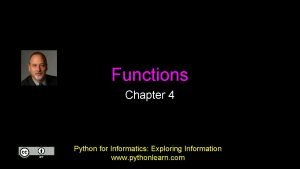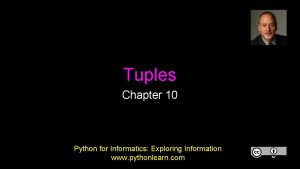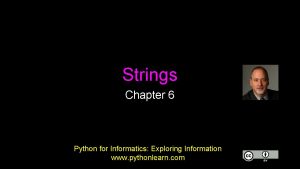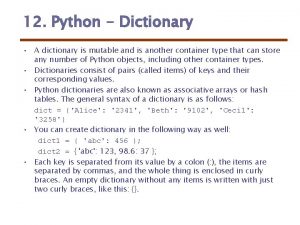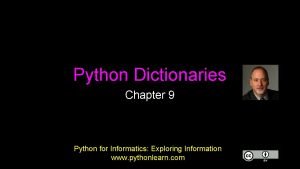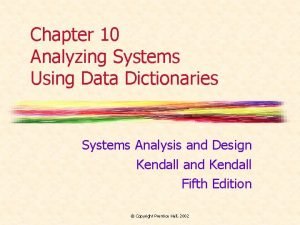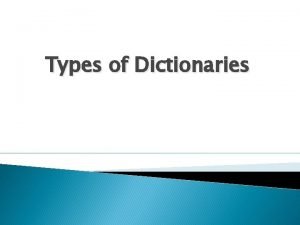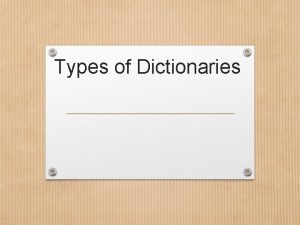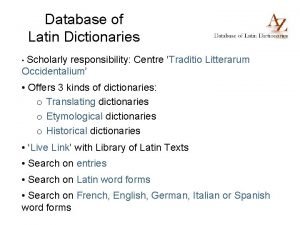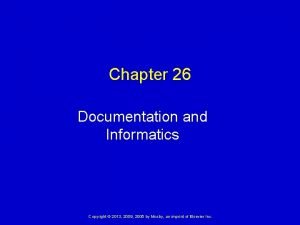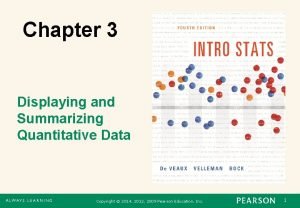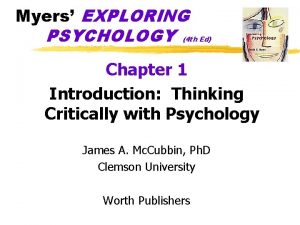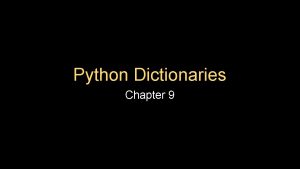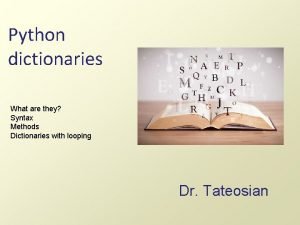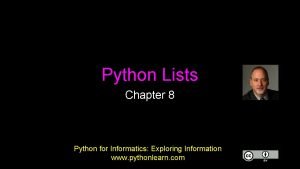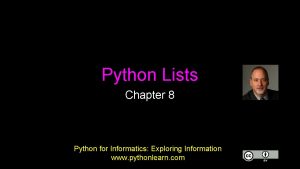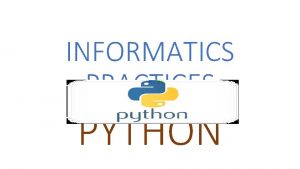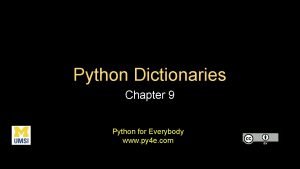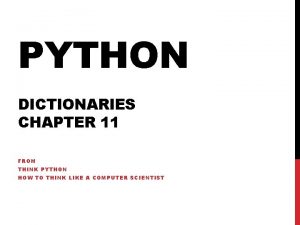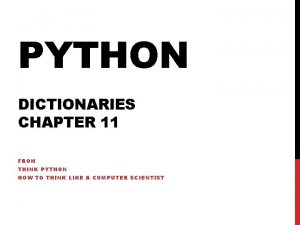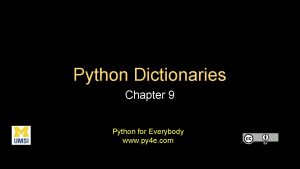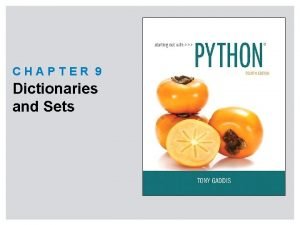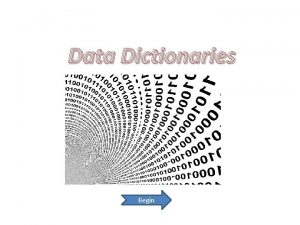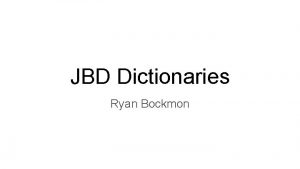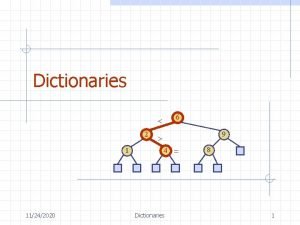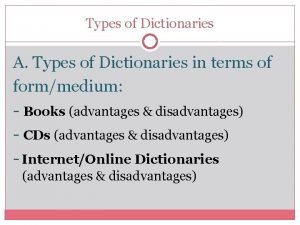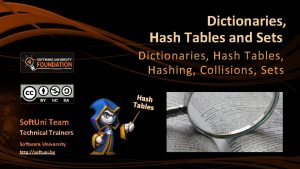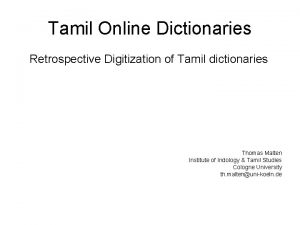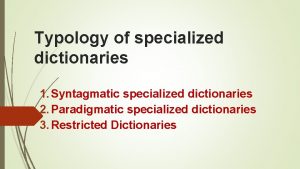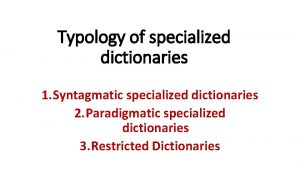Python Dictionaries Chapter 9 Python for Informatics Exploring








![money candy tissues 12 3 75 >>> purse = dict() >>> purse['money'] = 12>>> money candy tissues 12 3 75 >>> purse = dict() >>> purse['money'] = 12>>>](https://slidetodoc.com/presentation_image_h/046a7baab4295b0f4f869b79791b3a7b/image-9.jpg)





















- Slides: 30

Python Dictionaries Chapter 9 Python for Informatics: Exploring Information www. pythonlearn. com

Unless otherwise noted, the content of this course material is licensed under a Creative Commons Attribution 3. 0 License. http: //creativecommons. org/licenses/by/3. 0/. Copyright 2010 - Charles Severance

What is a Collection? • • A collection is nice because we can put more than one value in them and carry them all around in one convenient package. We have a bunch of values in a single “variable” We do this by having more than one place “in” the variable. We have ways of finding the different places in the variable

What is not a “Collection” • Most of our variables have one value in them - when we put a new value in the variable - the old value is over written $ python Python 2. 5. 2 (r 252: 60911, Feb 22 2008, 07: 53) [GCC 4. 0. 1 (Apple Computer, Inc. build 5363)] on darwin >>> x = 2 >>> x = 4 >>> print x 4

A Story of Two Collections. . • List • • A linear collection of values that stay in order Dictionary • A “bag” of values, each with its own label

Dictionaries tissue calculator perfume money candy http: //en. wikipedia. org/wiki/Associative_array

Dictionaries • • • Dictionaries are Python’s most powerful data collection Dictionaries allow us to do fast database-like operations in Python Dictionaries have different names in different languages • • • Associative Arrays - Perl / Php Properties or Map or Hash. Map - Java Property Bag - C# /. Net http: //en. wikipedia. org/wiki/Associative_array

Dictionaries • • • Lists index their entries based on the position in the list Dictionaries are like bags - no order So we index the things we put in the dictionary with a “lookup tag” >>> purse = dict()>>> purse['money'] =
![money candy tissues 12 3 75 purse dict pursemoney 12 money candy tissues 12 3 75 >>> purse = dict() >>> purse['money'] = 12>>>](https://slidetodoc.com/presentation_image_h/046a7baab4295b0f4f869b79791b3a7b/image-9.jpg)
money candy tissues 12 3 75 >>> purse = dict() >>> purse['money'] = 12>>> purse['candy'] = 3>>> purse['tissues'] = 75 >>> print purse{'money': 12, 'tissues': 75, 'candy': 3} candy >>> print purse['candy']3 5 >>> purse['candy'] = purse['candy'] + 2 >>> print purse{'money': 12, 'tissues': 75, 'candy': 5}

Comparing Lists and Dictionaries • Dictionaries are like Lists except that they use keys instead of numbers to look up values >>> ddd = dict() >>> lst = list()>>> lst. append(21)>>> lst. append(183)>>> print lst[21, >>> ddd['age'] = 21>>> ddd['course

List Key Value >>> lst = list()>>> lst. append(21)>>> lst. append(183)>>> print lst[21, 1 [0] 21 23 [1] 183 lll Dictionary Key Value >>> ddd = dict()>>> ddd['age'] = 21>>> ddd['course'] = 182>>> print dd [course] 183 23 [age] 21 ddd

Dictionary Literals (Constants) • • Dictionary literals use curly braces and have a list of key : value pairs You can make an empty dictionary using empty curly braces >>> jjj = { 'chuck' : 1 , 'fred' : 42, 'jan': 100} >>> print jjj {'jan': 100, 'chuck': 1, 'fred': 42} >>> ooo = { }>>> print ooo{} >>>

Most Common Name? marquard cwen zhen csev marquard csev cwen zhen

Most Common Name?

Most Common Name? marquard cwen zhen csev marquard csev cwen zhen

Many Counters with a Dictionary • One common use of dictionary is counting how often we “see” something >>> ccc = dict() >>> ccc['csev'] = 1 >>> ccc['cwen'] = 1 >>> print ccc {'csev': 1, 'cwen': 1} >>> ccc['cwen'] = ccc['cwen'] + 1 >>> print ccc {'csev': 1, 'cwen': 2} Key Value

Dictionary Tracebacks • • It is an error to reference a key which is not in the dictionary We can use the in operator to see if a key is in the dictionary >>> ccc = dict() >>> print ccc['csev'] Traceback (most recent call last): File "<stdin>", line 1, in <module> Key. Error: 'csev' >>> print 'csev' in ccc False

• When we see a new name When we encounter a new name, we need to add a new entry in the dictionary and if this the second or later time we have seen the name, we simply add one to the count in the dictionary under that name counts = dict() names = ['csev', 'cwen', 'csev', 'zqian', 'cwen']for name in names : else : counts[name] = counts[name] + 1 print counts if nam {'csev': 2, 'zqian': 1, 'cwen': 2}

The get method for dictionary • This pattern of checking to see if a key is already in a dictionary and assuming a default value if the key is not there is so common, that there is a method called get() that does this for us Default value if key does not exist (and no Traceback). if name in counts: print counts. get(name, 0) {'csev': 2, 'zqian': 1, 'cwen': 2}

Simplified counting with get() • We can use get() and provide a default value of zero when the key is not yet in the dictionary - and then just add one counts = dict() names = ['csev', 'cwen', 'csev', 'zqian', 'cwen']for name in names : counts[name] = counts. get(name, 0) + 1 print counts Default {'csev': 2, 'zqian': 1, 'cwen': 2}

Writing programs (or programming) is a very creative and rewarding activity. You can write programs for many reasons ranging from making your living to solving a difficult data analysis problem to having fun to helping someone else solve a problem. This book assumes that everyone needs to know how to program and that once you know how to program, you will figure out what you want to do with your newfound skills. We are surrounded in our daily lives with computers ranging from laptops to cell phones. We can think of these computers as our ``personal assistants'' who can take care of many things on our behalf. The hardware in our current-day computers is essentially built to continuously ask us the question, ``What would you like me to do next? ''. Our computers are fast and have vasts amounts of memory and could be very helpful to us if we only knew the language to speak to explain to the computer what we would like it to ``do next''. If we knew this language we could tell the computer to do tasks on our behalf that were reptitive. Interestingly, the kinds of things computers can do best are often the kinds of things that we humans find boring and mind-numbing.

the clown ran after the car and the car ran into the tent and the tent fell down on the clown and the car

Counting Pattern The general pattern to count the words in a line of text is to split the line into words, then loop thrugh the words and use a counts = dict()print 'Enter a line of text: 'line = raw_input('') dictionary to track the count of words = line. split()print 'Words: ', wordsprint 'Counting. . . 'for word in words each word independently.

Counting Words python wordcount. py Enter a line of text: the clown ran after the car and the car ran into the tent and the tent fell down on the clown and the car Words: ['the', 'clown', 'ran', 'after', 'the', 'car', 'and', 'the', 'car', 'ran', 'into', 'the', 'tent', 'and', 'the', 'tent', 'fell', 'down', 'on', 'the', 'clown', 'and', 'the', 'car'] Counting. . . Counts {'and': 3, 'on': 1, 'ran': 2, 'car': 3, 'into': 1, 'after': 1, 'clown': 2, 'down': 1, 'fell': 1, 'the': 7, 'tent': 2} http: //www. flickr. com/photos/71502646@N 00/2526007974/

python wordcount. py Enter a line of text: the clown ran after the car and the car ran into the tent and the tent fell down on the clown and the car Words: ['the', 'clown', 'ran', 'the', 'car', 'and', 'the', 'car', counts = dict()print 'Enter a line of text: 'line ='after', raw_input('') 'ran', 'into', 'the', 'tent', 'and', 'the', words = line. split()print 'Words: ', wordsprint 'Counting. . . 'for word in words: counts[word] = co 'tent', 'fell', 'down', 'on', 'the', 'clown', 'and', 'the', 'car']Counting. . . Counts {'and': 3, 'on': 1, 'ran': 2, 'car': 3, 'into': 1, 'after': 1, 'clown': 2, 'down': 1, 'fell': 1, 'the': 7, 'tent': 2}

Definite Loops and Dictionaries • Even though dictionaries are not stored in order, we can write a for loop that goes through all the entries in a dictionary - actually it goes through all of the keys in the dictionary and looks up the values >>> counts = { 'chuck' : 1 , 'fred' : 42, 'jan': 100}>>> for key in counts: . . . print ke

Retrieving lists of Keys and Values • You can get a list of keys, values or items (both) from a dictionary >>> jjj = { 'chuck' : 1 , 'fred' : 42, 'jan': 100} >>> print list(jjj) ['jan', 'chuck', 'fred'] >>> print jjj. keys() ['jan', 'chuck', 'fred'] >>> print jjj. values() [100, 1, 42] >>> print jjj. items()[('jan', 100), ('chuck', 1) What is a 'tuple'? - coming soon. . .

Bonus: Two Iteration Variables! • • We loop through the key-value pairs in a dictionary using *two* iteration variables Each iteration, the first variable is the key and the second variable is the corresponding value for the key >>> jjj = { 'chuck' : 1 , 'fred' : 42, 'jan': 100} >>> for aaa, bbb in jjj. items() : . . . print aaa, bbb. . . jan 100 aaa bbb chuck 1 fred 42 [jan] 100 >>> [chuck] 1 [fred] 42

python words. py Enter file: words. txt to 16 name = raw_input("Enter file: ")handle = open(name, 'r')text = handle. read()words counts = dict()for word in words: counts[word] = counts. get(word, 0) + 1 bigcount python words. py Enter file: clown. txt the 7 Dictionaries

Summary • What is a collection? • Lists versus Dictionaries • Dictionary constants • The most common word • Using the get() method • Hashing, and lack of order
 Python for informatics
Python for informatics Python for informatics
Python for informatics Python for informatics: exploring information
Python for informatics: exploring information Python for informatics: exploring information
Python for informatics: exploring information Dictionaries are mutable or immutable in python
Dictionaries are mutable or immutable in python Python for informatics
Python for informatics Data dictionary system analysis and design
Data dictionary system analysis and design Types of dictionaries
Types of dictionaries Types of dictionaries
Types of dictionaries Kirrkirr
Kirrkirr Database of latin dictionaries
Database of latin dictionaries Chapter 26 informatics and documentation
Chapter 26 informatics and documentation Career skills in health informatics chapter 2
Career skills in health informatics chapter 2 Chapter 26 exploring the universe answers
Chapter 26 exploring the universe answers Exploring religions chapter 4 large
Exploring religions chapter 4 large Development takes place gradually
Development takes place gradually Exploring globalization textbook pdf chapter 11
Exploring globalization textbook pdf chapter 11 Judaismn
Judaismn Exploring the religions of our world chapter 1 pdf
Exploring the religions of our world chapter 1 pdf Exploring religions chapter 6 large
Exploring religions chapter 6 large Exploring the religions of our world pdf
Exploring the religions of our world pdf Chapter 3 displaying and summarizing quantitative data
Chapter 3 displaying and summarizing quantitative data Chapter 2 exploring the americas study guide
Chapter 2 exploring the americas study guide Chapter 2 exploring the americas answers
Chapter 2 exploring the americas answers Chapter 1 biology exploring life
Chapter 1 biology exploring life Exploring psychology chapter 1
Exploring psychology chapter 1 Exploring lifespan development chapter 1
Exploring lifespan development chapter 1 Sociocultural graded influences
Sociocultural graded influences Formuö
Formuö Typiska drag för en novell
Typiska drag för en novell Nationell inriktning för artificiell intelligens
Nationell inriktning för artificiell intelligens
